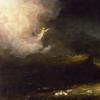“Modern Life: Edward Hopper and His Time” at the Whitney
- November 07, 2010 17:33
Edward Hopper's art delivers a soulful take on living in the industrial age.
“The inner life of a human being is a vast and varied realm,” he wrote, “and does not concern itself alone with stimulating arrangements of colour, form and design.”
In the current exhibition at the Whitney Museum of American Art in New York, the artistic vision of Hopper is shown alongside the varied works of his contemporaries such as John Sloan, Alfred Stieglitz, Edward Steichen, Paul Strand, Charles Demuth, Guy Pène du Bois, Charles Sheeler, Charles Burchfield, Ben Shahn, and Reginald Marsh.
Together, eighty of their works provide a compelling view of early 20th-century America and trace the development of realism from 1900 to 1940, in styles ranging from Ashcan School to Precisionist to American Scene.
Drawn primarily from the Whitney's vast holdings of Hopper works (a bequest of his wife Jo) is “New York Interior,” a snapshot-like, voyeuristic scene painted in 1921 which depicts a half-dressed girl framed in a city window. Ariella Budick writes in the Financial Times, "...the way Hopper has lit, framed and composed her, with one sinewed arm extended to disrupt the symmetrical triangular geometry of her pose, she becomes a study in isolation."
The show runs through April 10, 2011, and is accompanied by a 250-page illustrated catalogue with essays by American and German scholars, produced in conjunction with an exhibition of the same title which appeared at the Bucerius Kunst Forum, Hamburg, and the Kunsthal Rotterdam in 2009-10.




















